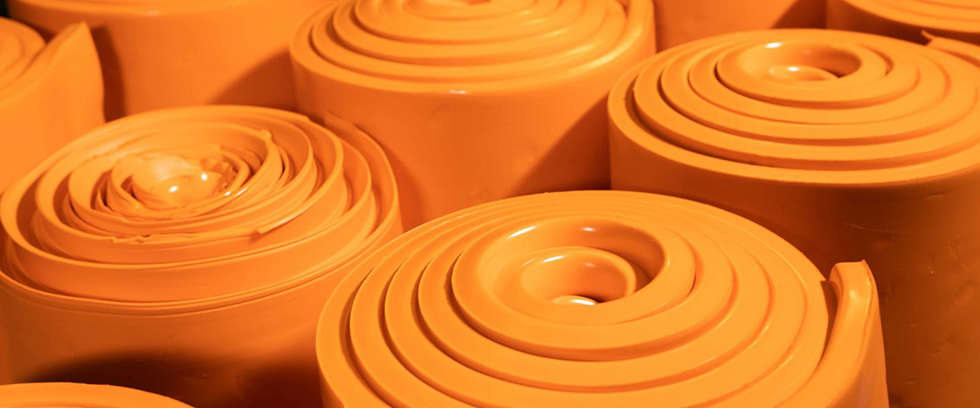
1. Natural rubber and solvents
Raw rubber is insoluble in water, alcohol,acetone, ethers, and other solvents, but it can slowly dissolve in thefollowing solvents to form a colloidal solution, such as naphtha, benzene,toluene, xylene, decahydro naphthalene, turpentine, carbon tetrachloride,chloroform, dichloromethane, pentachloromethane, tetrachloromethane, and carbondisulphide.
When raw rubber dissolves in solvents, itfirst swells and then gradually disperses into a viscous solution. This isbecause raw rubber is formed by the polymerisation of isoprene (C,H) into anetwork structure, which also contains low-polymerisation-degree isoprenemolecules. Solvent molecules first cause the oligomers to swell, disrupting thenetwork structure, while also causing the polymers to swell and disperse into acolloidal state, leading to dissolution.
Raw rubber that has undergoneplasticisation dissolves faster than untreated raw rubber, forms a more uniformsolution, and has lower viscosity. The order of solvent dissolution rates forraw rubber is as follows:
trichloroethylene > hexachlorethane >pentachlorethane > carbon tetrachloride > chloroform > carbondisulphide > benzene > toluene > xylene > naphtha > kerosene.
Solubility characteristics of raw rubber in various solvents
| Solvent Name | Solubility Characteristics |
| Alkanes | Can completely disperse raw rubber. Cycloalkane solvents have greater dispersing ability than alkane solvents. When benzene is added to gasoline, its solubility increases. |
| Aromatic hydrocarbons | Completely dispersed, with a transparent solution. |
| Chlorides | Completely dispersed, but the solution is turbid. |
| Alcohols | Does not dissolve raw rubber, but when added to other solutions, it reduces the solution's viscosity. |
| Ketones | Has the same effect as alcohol solvents. Dissolves chlorinated rubber. |
| Esters | Solubility of chlorinated rubber |
| Carbon disulphide | Dissolves raw rubber but is flammable and toxic |
2. Vulcanised rubber and solvents
Vulcanised rubber is difficult to dissolvein solvents, and even if it contains a small amount of sulphur in itsmolecules, its solubility is significantly reduced. However, when vulcanisedrubber is heated at 180–200°C for an extended period in a solvent, it can betransformed into a uniform solution. Table 5-11 shows the expansion degree ofvulcanised rubber (rubber 95, sulphur 5, vulcanisation coefficient 4.54) at25°C.
Swelling of vulcanized rubber
| Solvent Name | Degree of swelling | Solvent name | Degree of swelling | Solvent name | Degree of swelling |
| Carbon tetrachloride | 659 | Decahydronaphthalene | 510 | Cyclohexanecarboxylic acid ethyl ester | 307 |
| Chloroform | 651 | Toluene | 504 | Paraffin oil | 303 |
| Carbon disulphide | 583 | Cyclohexane | 458 | Acetic acid | 243 |
| Tetrahydro naphthalene | 564 | Volatile oil | 389 | Pentyl acetate | 237 |
3. Synthetic Rubber and Solvents
(1) Buna Rubber
The solubility of Buna rubber in solventsis nearly identical to that of natural rubber, except for Buna N rubber (a copolymerof butadiene and acrylonitrile, i.e., nitrile rubber), Buna S rubber (acopolymer of butadiene and styrene, i.e., styrene-butadiene rubber), Buna 85rubber, and 115 rubber (polybutadiene rubber catalysed by metallic sodium).Buna N rubber does not swell in mineral oils or volatile oils, with onlyminimal volume increase. This is fundamentally different from natural rubberproducts. Vulcanised Buna N rubber exhibits slight swelling in aliphatichydrocarbons, vegetable oils, and animal fats. Therefore, Buna N rubber hasexcellent oil resistance.
(2) Chloroprene rubber
Chloroprene rubber has better oilresistance than natural rubber. The extent to which solvents cause chloroprenerubber to swell depends on the type of solvent or oil. Solvents with the weakestswelling ability include petroleum, lubricating oil, and vegetable oils; thosewith slightly stronger swelling ability include crude oil, fuel oil, oleicacid, fish oil, and paraffin oil; and the solvents with the strongest swellingcapacity include benzene and its derivatives, carbon tetrachloride, chlorinatedhydrocarbons, naphtha, turpentine, paint thinners, and carbon disulphide.
(3) Polysulphide Synthetic Rubber
This type of rubber is synthesised fromorganic polysulphide compounds and has excellent oil resistance and ageingresistance.
Oil resistance of ethylene tetrasulphide polymers
| Solvent | % * | Solvent | % * | Solvents | % * |
| Benzene | 0. 40 | Kerosene | 0 | Chloroform | 15.38 |
| Gasoline | 0 | Ethanol | 0 | Carbon disulphide | dissolve |
| Toluene | 0 | Turpentine | 0 | Ether | 0 |
| Solvent gasoline | 0. 35 | Carbon tetrachloride | .2.14 | Acetone | 0 |
* Refers to the percentage increase in mass after immersion at room temperature for 72 hours.
4. Solvents for the rubber industry
Solvents have multiple applications in therubber industry, primarily divided into the following two categories:
(1) Rubber refining: During plasticisation,solvents can temporarily serve as plasticisers and desulphurisation agents.
(2) Processing (primarily rubber paste) Solventscan be used as coating solvents for fabrics, spraying solvents, and adhesivesolvents. In addition to turpentine, solvents used in the rubber industryinclude naphtha (containing aliphatic hydrocarbons, cycloalkanes, and aromatichydrocarbons), benzene, toluene, xylene, decahydro naphthalene, carbontetrachloride, 1,2-dichloroethane, trichloroethane, tetrachloroethane,pentachloroethane, dichloromethane, and carbon disulphide.

